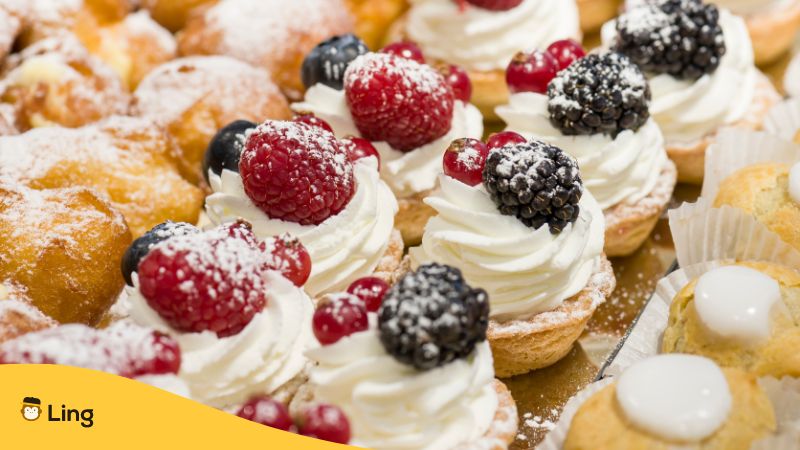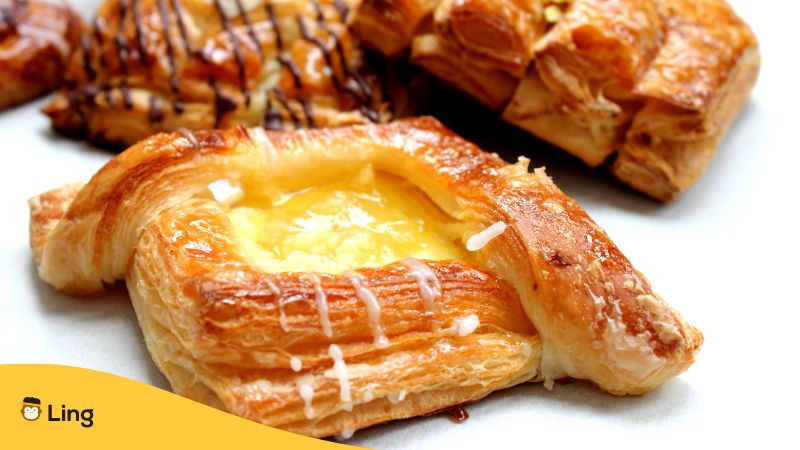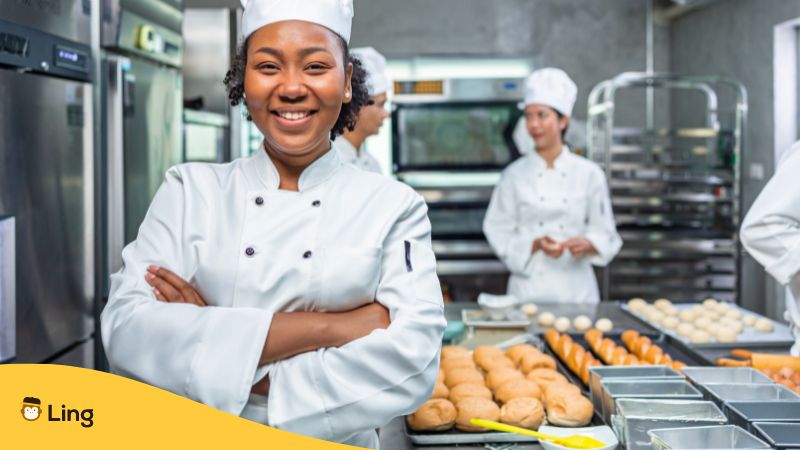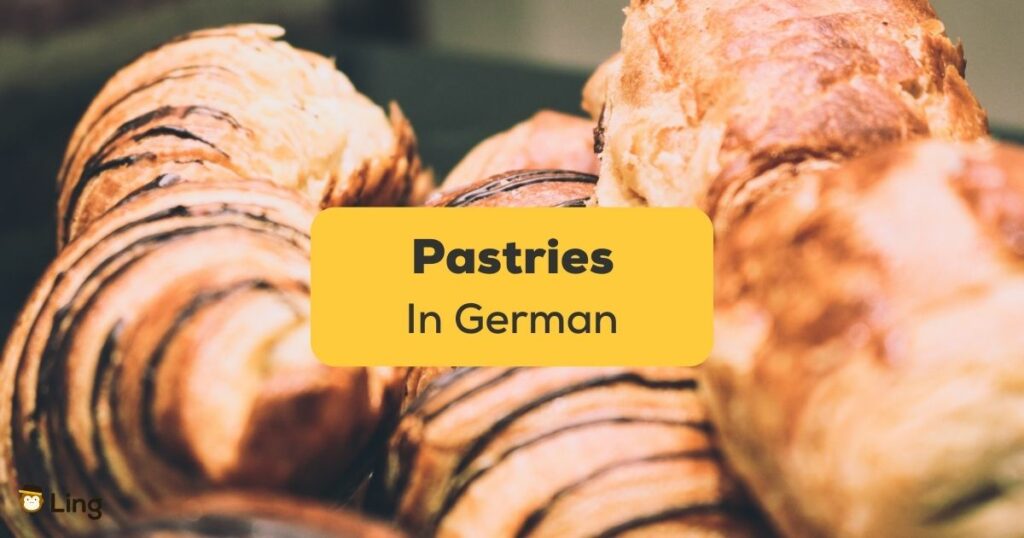Ever find yourself daydreaming about those fluffy, sugary, mouthwatering delights like Apfelstrudel and Streuselkuchen? Well, buckle up because we’re about to take a tasty journey to the land of beer and bratwurst, Germany! But wait, we’re not here for the sausages or the pretzels, no-no! We’re here to dive into the sweet, buttery world of German pastry vocabulary and more. Let’s get started!
What’s the first thing that pops into your mind whenever you hear the place Germany? Let me guess, adorable provincial towns dotted with charming, rustic homes, right? Perhaps, you’re also thinking of those cobblestone streets that look like they’ve been lifted straight out of a fairy tale and shops so quaint they’d make fairytale characters swoon. But let’s push that scene aside for a moment because there’s a hidden gem in Germany that you need to know of: die Bäckereien or the bakeries!
When I first set foot in this country, it wasn’t just the stunning landscapes that made me fall head over heels. It was the irresistibly sweet, comforting scent of baking that enveloped me, pulling me in like a moth to a flame. It was just the kind of smell that’ll make your stomach do a happy dance!
I mean, sure, I’ve had pastries before, but nothing, and I mean NOTHING, prepared me for the deliciousness that awaited me in those German bakeries. From basic Brötchen (bun) and Berliner (jelly doughnut) to the Schwarzwälder Kirschtort (black forest cake) and the lightly glazed Schnecken (sweet roll), I knew from the moment I took a bite that I was destined to gorge on these German pastries and live my best carb-loaded life.
And so in this post, I’ll be teaching you some basic German words related to these heavenly pastries so that you can express yourself and connect better with the German people. Let’s begin!

Why Are German Pastries Unique?
Germany has a rich and varied culinary history, and nothing represents this better than its array of delectable Gebäck or pastries. For me, German pastries are not just food, they’re a symbol, a story. Each crumb and each flake tells a tale of the country’s rich culinary heritage and the culinary skill that goes into every single bake. I mean, can we take a moment to appreciate those German monks from yesteryears? They were the OG master bakers who took the simplest of ingredients and transformed them into edible pieces of art!
Oh, and here’s a little tidbit you’ll be surprised to know. Ever wondered about those braided pastries you find in every German bakery? Like the Rosinenzopf (sweet raisin braid) and Nusszopf (sweet nut braid)? Turns out, they’re not just Instagrammable delights but carry deep cultural significance! Back in pagan times, it was common for women to chop off plaits of their hair and place them in coffins as a symbol of their love for the deceased.
Sounds a bit grim, doesn’t it? But hey, over time, these hair plaits evolved into something much tastier – yes, the braided bread we know and love.
So, the next time you’re munching on a delicious German pastry, remember you’re not just savoring a treat; you’re biting into a piece of history. Ready to explore more? Let’s knead our way through this journey!

Common German Pastry Vocabulary
Now that you know what makes German baked snacks unique, let’s now go over the common vocabulary words for pastries in the German language. Also, don’t forget to try out these words by using your favorites in complete sentences following this sentence pattern: Ich liebe + German Pastries.
Here are some examples:
- I love cakes = Ich liebe Kuchen.
- I love baguettes = Ich liebe Baguettes.
- I love croissants = Ich liebe Croissants.
Ready to learn German translations? Check out the table below!
| English | German | Example Pastries |
|---|---|---|
| English | German | Example Pastries |
| Pies | Torten | Erdbeertorte (strawberry pie), Käsesahnetorten (cream cheese pie) |
| Tarts | Tarte | Zitronentarte (Lemon Tart), Obsttarte (Fruit Tart), Schokoladentarte (Chocolate Tart) |
| Croissants | Croissants | Mandelcroissant (Almond Croissant), Schokoladencroissant (Chocolate Croissant) |
| Puff Pastries | Blätterteig | Blätterteig mit Sahnefüllung (Puff Pastry with Cream), Blätterteig mit Fruchtfüllung (Puff Pastry with Fruit), Blätterteig mit Fleischfüllung (Puff Pastry with Meat) |
| Éclairs | Eclairs | Schokoladen-Éclair (Chocolate Éclair), Vanille-Éclair (Vanilla Éclair), Kaffee-Éclair (Coffee Éclair) |
| Scones | Scones | Scones mit Früchten (Fruit Scones), Scones mit Nüssen (Nut Scones) |
| Muffins | Muffins | Blaubeer-Muffin (Blueberry Muffin), Schokoladen-Muffin (Chocolate Chip Muffin), Bananen-Muffin (Banana Muffin) |
| Cakes | Kuchen | Biskuitkuchen (Sponge Cake), Pfundkuchen (Pound Cake), Genoise |
| Cookies | Kekse/Plätzchen | Vanillekipferl (Vanilla crescents), Spritzgebäck (shortbread cookies), Kokos-Makronen (Coconut macaroons), Lebkuchen (Gingerbread) |
Types Of Dough In the German Language
Germany, with its rich baking tradition, is home to many different types of dough. Each dough type has its unique characteristics, and understanding them can enhance your baking experience. Here’s a look at some of the most common types of dough you’ll encounter in German baking.
| English | German | Description |
|---|---|---|
| Flaky Dough | Blätterteig | This type of dough creates pastries that are light and airy with many flaky layers. It’s perfect for creating German classics like the Apfeltasche (apple turnover). |
| Shortcrust Dough | Mürbeteig | Known for its crumbly texture, this dough is commonly used in making cookies and tarts like the classic Linzer Torte. |
| Puff Dough | Plunderteig | A version of flaky dough with yeast, often used for pastries like croissants or Danish pastries. |
| Choux Dough | Brandteig | This dough puffs up in the oven, creating a hollow inside perfect for filling. It’s typically used in pastries like éclairs or cream puffs. |
| Filo Dough | Filoteig | This thin, light dough is used to make pastries like strudel. It’s known for its delicate layers and crisp texture when baked. |
Common Ingredients For Baking In German
If you’ve ever fantasized about recreating those melt-in-your-mouth German pastries in your own kitchen, you’re in the right place. But before you can start whipping up a storm, you need to know your Zutaten (ingredients) in German. After all, you wouldn’t want to confuse your Zucker (sugar) with your Salz (salt), would you? Let’s learn that and more in this section!
| English | German |
|---|---|
| Flour | das Mehl |
| Sugar | der Zucker |
| Baking powder | das Backpulver |
| Yeast | die Hefe |
| Salt | das Salz |
| Butter | die Butter |
| Eggs | die Eier |
| Milk | die Milch |
| Water | das Wasser |
| Vanilla extract | das Vanilleextrakt |
| Cinnamon | der Zimt |
| Cocoa powder | das Kakaopulver |
| Cream | die Sahne |
| Chocolate | die Schokolade |
| Lemon | die Zitrone |
| Almonds | die Mandeln |
| Raisins | die Rosinen |
| Poppy seeds | der Mohn |
| Powdered sugar | der Puderzucker |
| Honey | der Honig |

Baking-Related Verbs In German
Ready to follow some German dessert recipes? Whether you’re thinking of baking gingerbread or famous Weimarer Zwiebelkuchen, here is the best list of verbs to help you out in your journey.
| English | German |
|---|---|
| To bake | backen |
| To mix | mischen |
| To whisk | schlagen |
| To stir | rühren |
| To knead | kneten |
| To roll out | ausrollen |
| To preheat | vorheizen |
| To measure | messen |
| To sift | sieben |
| To grease | einfetten |
| To cut | schneiden |
| To pour | gießen |
| To cool | abkühlen |
| To frost/ice | glasieren |
| To sprinkle | streuen |
| To melt | schmelzen |
| To fold in | unterheben |
| To rise (for dough) | aufgehen |
These verbs should give you a solid foundation in the German baking lingo. So, the next time you come across a German recipe, you’ll have no problem whipping up a delicious treat!
Ready To Master The German Language?
As we learned in this post, German pastries are like the secret superstars of the culinary world. Seriously, they’re not just good, they’re mind-blowingly, ridiculously good! And they’re not just about the taste. Each pastry tells a story, a delicious, crumbly, sweet tale of German history and culture. Experience the variety of fruits in all the delicious pastries and see, better taste for yourself!
Fancy trying your hand at whipping up these scrumptious goodies? Or maybe you’re dreaming of a chit-chat with a friendly German baker as they pull fresh Brötchen from the oven? Well, we’ve got just the thing for you – Ling!
Ling is this super cool language-learning platform that’s got everything you need to master German and over 60 other languages. It’s packed with all these innovative features that make learning fun, and lessons so in-depth, you’ll feel like you’re absorbing the language through osmosis!
Ready to dive into the beautiful world of German? Get started with Ling today – it’s totally free to sign up! You can even download it from the App Store or Play Store and turn your phone into your personal language tutor. So, what are you waiting for? Your German pastry adventure awaits!





































